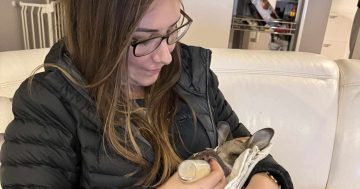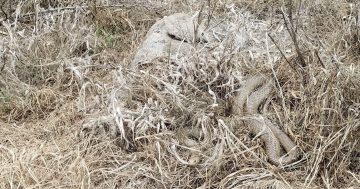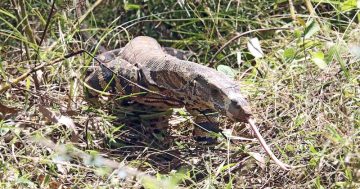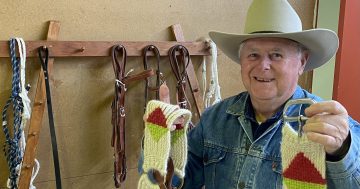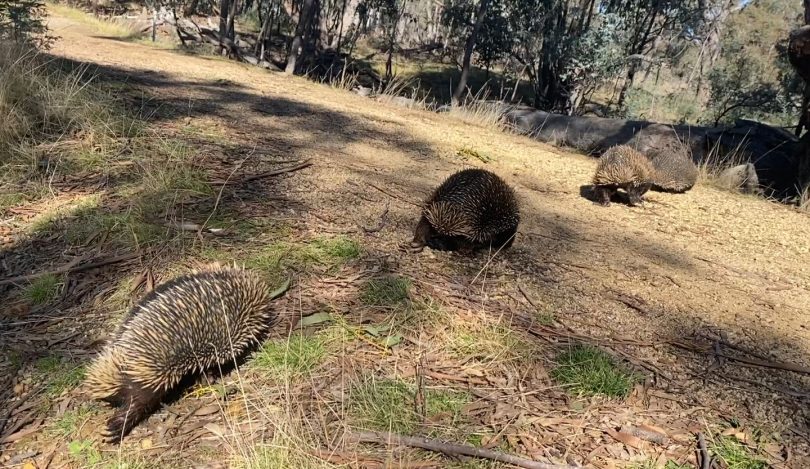
If you were lucky enough to spot an echidna train, you might need to be on the lookout for something a little smaller now. Photo: WWT/ Millie Sutherland Saines.
As echidna mating (and echidna train) season comes to an end, Wildcare Queanbeyan is experiencing an increase in calls for assistance for puggles – baby echidnas – who find themselves injured or in the wrong place.
With five of these tiny animals already in care, Wildcare is appealing to the public to keep an eye out so that number doesn’t increase.
A puggle is the jellybean-sized end-product of echidna trains – a phenomenon seen between July and September where potential male suitors will follow the female echidna, all hoping to be the chosen one.
Wildcare member Diane Hinton explains that when puggles are born, they spend around 55 days in a pouch-like section of the mum’s abdomen. It’s only when they begin to grow spikes that the mum will send them into a burrow for about seven months, with the mum returning home every couple of days.
The last time the mum weans her young, she will simply leave the burrow entrance open and walk away – leaving the young to fend for itself.

When hatched, the puggle is the size of a jellybean. Photo: Diane Hinton.
Unfortunately, life isn’t always safe and easy for puggles in the suburbs and near busy roads.
Most puggles are being cared for are there because they have been hit by a car or unearthed. At other times, they find themselves in someone’s back garden where they might be attacked or harassed by dogs, Diane said.
Echidnas have a top speed of 2.3 kilometres per hour, so they are very vulnerable when crossing the road and when they get scared, they simply hunker down and refuse to move.
Diane urges people to remain vigilant when driving.
“If you do hit an echidna with your vehicle, or you come across one that has been hit, please check if it is still alive,” she said.
It’s also important to see if you can check its pouch and the surrounding area as puggles can be thrown a long distance.
Puggles, Diane says, look like little grey tennis balls. If the echidna is still alive, she asks you to move the animal and yourself to safety and call Wildcare to assist.
If the echidna can be moved, it’s best to use a towel or a car mat to pick it up off the road and move it in the direction it was already travelling.

And here’s the mum (or dad, it’s hard to tell) in the wild. Photo: Diane Hinton.
As for echidnas who arrive in your garden, Diane says the best method is to ensure the garden is quiet and free from dogs, people and other noise.
“If they are stressed, they will dig in and then it can take hours before they feel safe enough to come out of hiding and move on,” she said.
“Remember, they are within their home range and know where they are.”
If a dog and an echidna have had an encounter and there is blood on either one, the echidna should go into care with the Wildcare team.
If people want to attempt an echidna rescue by themselves, Diane has a couple of important tips.
Unfortunately, echidnas are often badly injured when people try to pick them up or dig them out using a shovel.
Instead, she says patience is your best friend.
They should be carried in a sturdy container that provides a cool, dark, and quiet environment, and echidnas shouldn’t be relocated.
“At this time of year, we must assume all echidnas may be female and have a puggle in a burrow. If you relocate the mum, the puggle will starve,” Diane said.
Contact the 24/7 Wildcare Helpline on 6299 1966 for assistance with sick, injured or orphaned native wildlife.
Original Article published by Lottie Twyford on The RiotACT.







